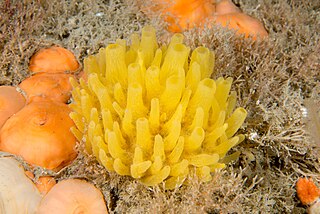Ascute is a genus of calcareous sponges. It contains two species, both found in Australia:

Grantia is a genus of calcareous sponges belonging to the family Grantiidae. Species of the genus Grantia contain spicules and spongin fibers.

Polymastia is a genus of sea sponges containing about 30 species. These are small to large encrusting or dome-shaped sponges with a smooth surface having many teat-shaped projections (papillae). In areas of strong wave action, this genus does not grow the teat structures, but instead grows in a corrugated form.
Hymeniacidon is a genus of sea sponges in the class Demospongiae. Some members of the genus are known to be mobile, achieving speeds of between 1 and 4 mm per day.
Iophon cheliferum, also known as the white reticulated sponge, is a species of sea sponge which lives on the bottom of the ocean. It is a deep water species found in the south eastern Pacific Ocean and South Africa.

Leuconia is a genus of calcareous sponges in the family Baeriidae. It was described by English anatomist and zoologist Robert Edmond Grant in 1833.

Sycon is a genus of calcareous sponges belonging to the family Sycettidae. These sponges are small, growing up to 7.5 cm with a length from 2.5 to 7.5 cm, and are tube-shaped and often white to cream in colour. They are known to aquarium hobbyists as "Pineapple" or "Q-Tip" sponges, and are frequent "hitchhikers" accidentally brought in.

Mycalidae is a family of marine demosponges.

Pelseneeria is a genus of very small ectoparasitic sea snails, marine gastropod mollusks or micromollusks in the family Eulimidae. This genus was first described by R. Koehler and C. Vaney in 1908.
Cribrochalina is a genus of sponges with eight described species.

Craniella is a genus of marine sponges in the family Tetillidae.

Rossellidae is a family of glass sponges belonging to the order Lyssacinosa. The family has a cosmopolitan distribution and is found at a large range of depths.

Baeriidae is a family of calcareous sponges in the class Calcarea. It was named by Borojevic, Boury-Esnault, and Vacelet in 2000. The type genus is BaeriaMiklucho-Maclay, 1870, by original designation, though Baeria is now considered a junior synonym of LeuconiaGrant, 1833.
Axoniderma is a genus of carnivorous demosponges in the family Cladorhizidae.

Discodermia is a genus of deep-water sea sponge.

Acanthella is a genus of sponges in the family Dictyonellidae, which was first described in 1862 by Eduard Oscar Schmidt. The type species is Acanthella acuta Schmidt, 1862.
Ascaltis is a genus of sponges in the family Leucascidae, first described in 1872 by Ernst Haeckel.

Leucetta is a genus of sponges in the family Leucettidae, which was first described in 1872 by Ernst Haeckel. The type species is Leucetta primigenia Haeckel, 1872 by subsequent designation.

Phakellia is a genus of sponges belonging to the family Bubaridae. The genus has a cosmopolitan distribution.
Ascoleucetta is a genus of sponges in the family Leucascidae, first described in 1924 by Arthur Dendy and Leslie M. Frederick.











